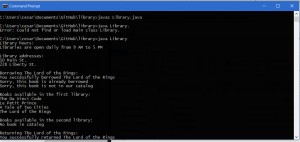--Originally published at JAVALIO

Object-Oriented Programming
--Originally published at JAVALIO
Great semester, I am very happy to end it, during this course I have learned so many things, now it feels like I am used to all this concepts but if I looking back a little bit I could see me in the early semester struggle with this new idea of Objects and stuff.
I’m very proud about what I learned because it cost me a lot at the begging, I want to say thank you to all my friends, teammates and ken for all the support they gave me, thanks to that I was abled to move on.
I really like the #AbolishGrade policy, no because it’s easier to get a good grate but because its an original way to test yourself, you don’t have to rush or keep a fool rubric but just do what you have to do without been insecure.
Here’s my video:

--Originally published at JAVALIO
James is the creator of Java programming language
He has always had a love for programming and the idea of create Java came up because He saw how difficult was to change from Hardware to Sowftware, there is no doubt He is one of the most important guys in this century, his programming language has reach an important role in programming nowadays.


--Originally published at JAVALIO
This guy just created one of the most important things in Internet nowadays, he is the creator of the concept of wiki, a place where everbody can share their knowledge, thanks to Ward Cunningham we have this special place call internet with important information
He also had contributed to the development of Eclipse and Relic and is part of the Smalltalk community. (hermesespinola.wordpress.com, 2016)


--Originally published at JAVALIO
In this WSQ I had the opportunity to discover a website that will help me in POO because there are some interesting problems, also they come very explained and with the answers if you want to check it
The library task was easy I just had to edit some things and it worked, I think the most important is the page is just found!


--Originally published at JAVALIO
Well I was kinda lost the first time I see those advices, I mean three or four I already expected by there are some that I did not see coming.
Let’s review some of the most important advices Joel Spolsky gave us.
This list is the whole advices, I will talk about Learn how to write before graduating, Learn C before graduating, and Take programming-intesnsive courses.
I wasn’t aware about the importance of writing. I mean, I have been in some competitions and always seems like the documentation is an important thing, but I never expected to be that important, but I could see why, is like the presentation to the world of your product, that product must sell, and attract to anybody.
Learning C before graduating, I guess is one of the most important things to do in my life, I have to many doubts about the how the low level programming happend, how os are build, how drivers work, so this is very important.
This is a important point I have learned with flipped classroom, you should always look for improving for yourself, taking courses, intensive course will help any programmer to be proactive and do more things by himself.

--Originally published at JAVALIO
Second time I face this problem, last time I was programming in Python, now is Java.
Yo soy 196, is about Palindrome, and Lychrel Number, is simple there exists palindrome(things that reads the same way left to rigth and otherwise) example rotator, reviver, denned, sexes, etc.
There also exist Palindrome number like 11, 22,33,44,55..(this are called Natural Palindrome, because by nature they can be read right to left and othewise), others numbers like 12 are palindrome but not for its nature, we need to add their inverse in order to find the Palindrome, 12 + 21 = 33, now 33 is palindrome but there are some numbers that we cannot find if they become palindrome after many iterations, these are called Lychrel Number the first example is 196 the first number that cannot be proved that reach a Palindrome
So our programm what do is receives a range and look for natural Palindromes, Palindromes after addinig, and candydates Lychrel numbers.
My codes in Github:
https://github.com/cesarau04/WSQ-Java/blob/master/WSQ08.java (main)
https://github.com/cesarau04/WSQ-Java/blob/master/MyRange.java (class MyRange)
Image by Eva the Weaver

--Originally published at JAVALIO
Second time I face this problem, last time I was programming in Python, now is Java.
Yo soy 196, is about Palindrome, and Lychrel Number, is simple there exists palindrome(things that reads the same way left to rigth and otherwise) example rotator, reviver, denned, sexes, etc.
There also exist Palindrome number like 11, 22,33,44,55..(this are called Natural Palindrome, because by nature they can be read right to left and othewise), others numbers like 12 are palindrome but not for its nature, we need to add their inverse in order to find the Palindrome, 12 + 21 = 33, now 33 is palindrome but there are some numbers that we cannot find if they become palindrome after many iterations, these are called Lychrel Number the first example is 196 the first number that cannot be proved that reach a Palindrome
So our programm what do is receives a range and look for natural Palindromes, Palindromes after addinig, and candydates Lychrel numbers.
My codes in Github:
https://github.com/cesarau04/WSQ-Java/blob/master/WSQ08.java (main)
https://github.com/cesarau04/WSQ-Java/blob/master/MyRange.java (class MyRange)
Image by Eva the Weaver

--Originally published at JAVALIO
Cesar Cortez and Andres Choza also worked with me during the WSQ07, here we came with a little more of knowlegde about Java, but even though we still have dounts.
Babylonian Method is about finding the root of a number but in a different way, first we have to see the number given like for example, 19, then look for a x number that x^2 is the closest number we can approch to 19.
For example: 1×1 = 1, 2×2 =4, 3×3=9, 4×4=16, 5×5=25
So 19 is (4^2) and (5^2 ), so we can infer that the root of 19 is 4.### something because is between 4×4 and 5×5
For more information I recommend you to see this video:
Our code in Github: https://github.com/cesarau04/WSQ-Java/blob/master/wsq07.java
Image by vasse nicolas,antoine.

--Originally published at JAVALIO
During this first exercise in programming Cesar Cortez, Andres Choza and me, worked together because we have doubts about how to begin in Java world, after we talk for minutes we decided to start and at the end of the day, all of us knew a little bit more of Java, I have to thank them because with their help I can programming better than before.
Greatest Commmon Divisor is a wsq where we have to find what’s the GCD of a number given, “when at least one of them is not zero, is the largest positive integer that divides the numbers without a remainder. For example, the GCD of 8 and 12 is 4” (Wikipedia,2016)
We use the method where you take both number and begin divide them by 2 then by 3 and go on, until the both of them cannot divide more with a same number, then multiply the numbers that pass and there is the result.
Here’s our code:
Github: https://github.com/cesarau04/WSQ-Java/blob/master/wsq06.java
Image by: Jorge Franganillo
